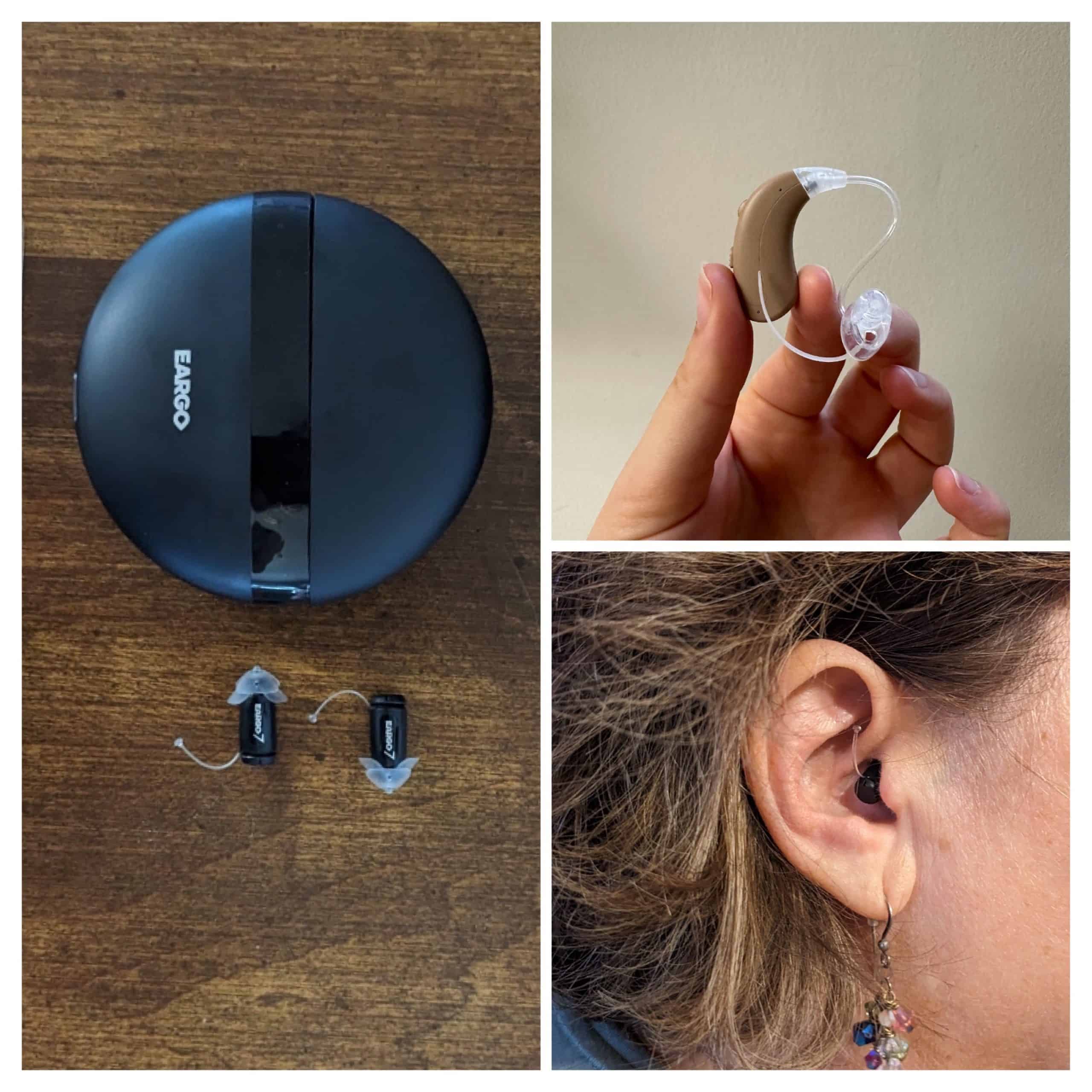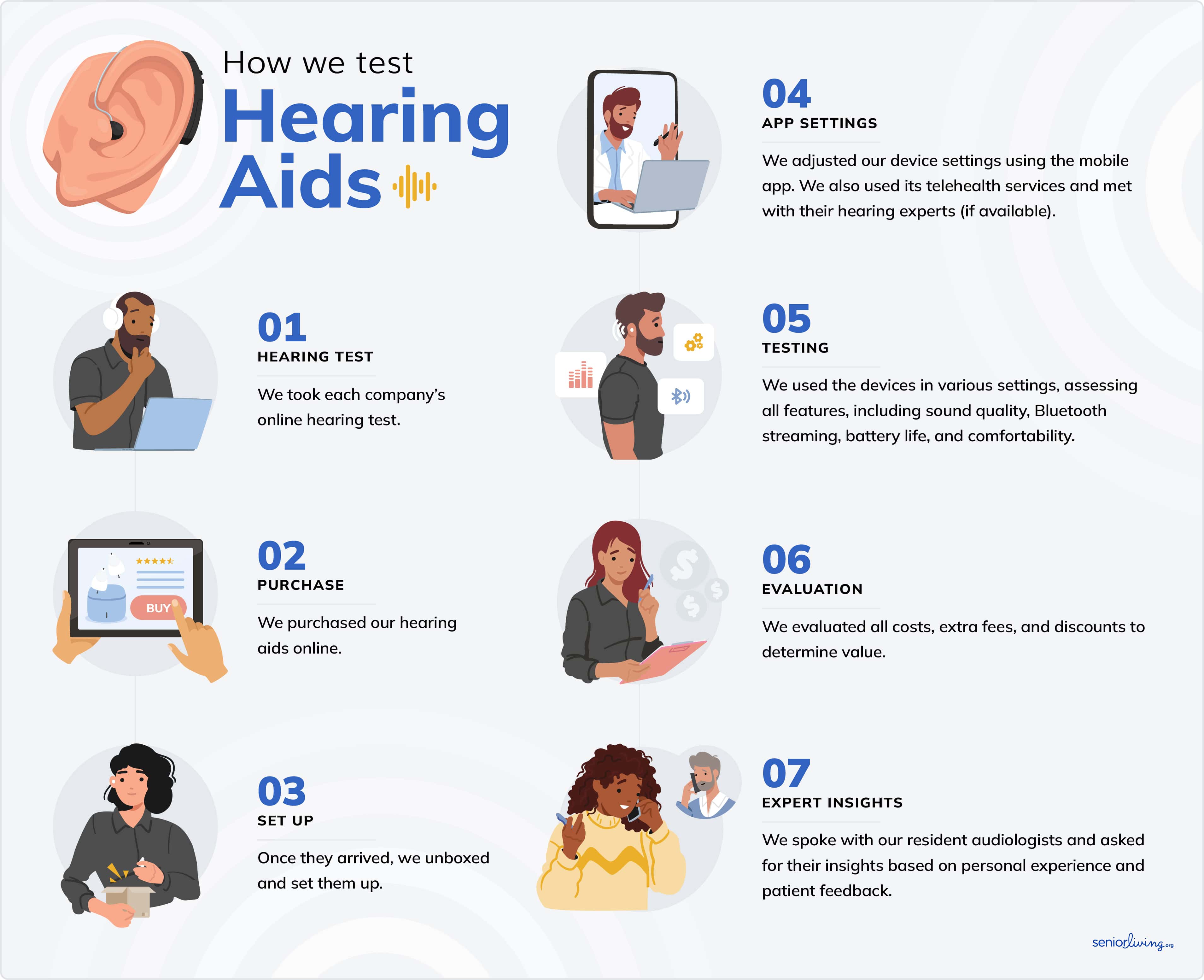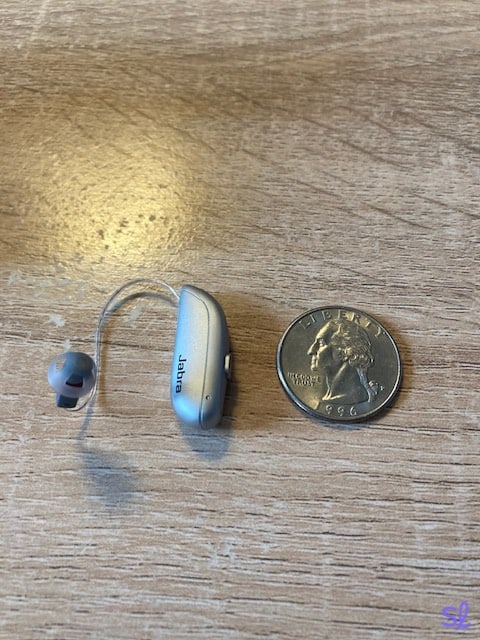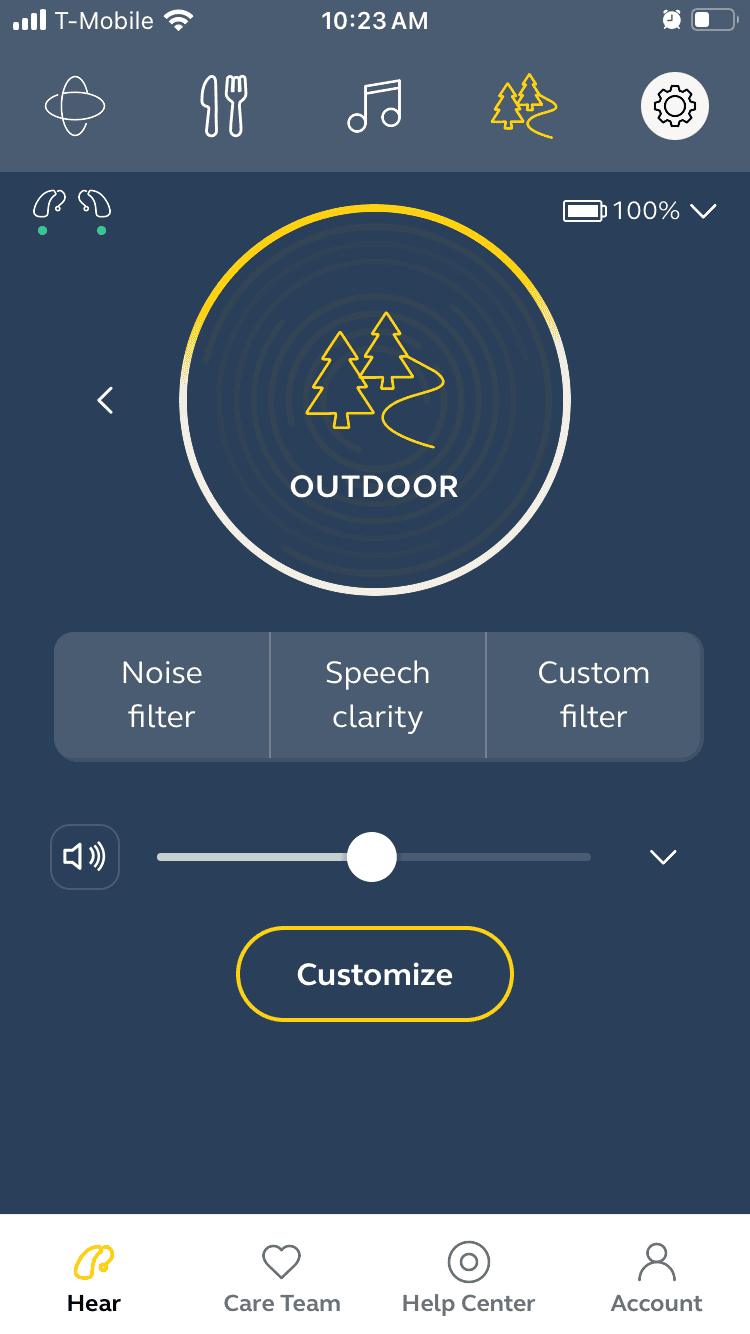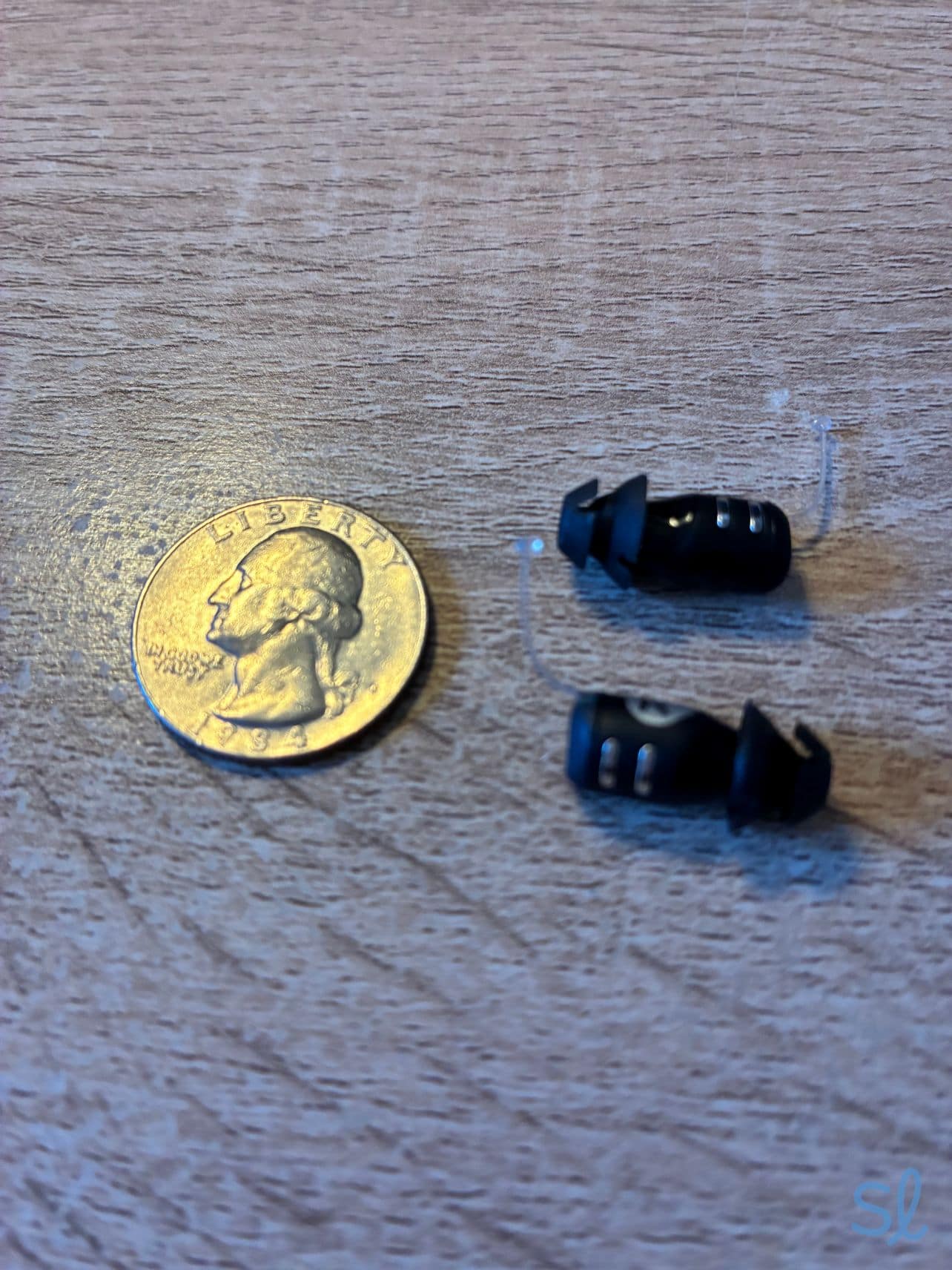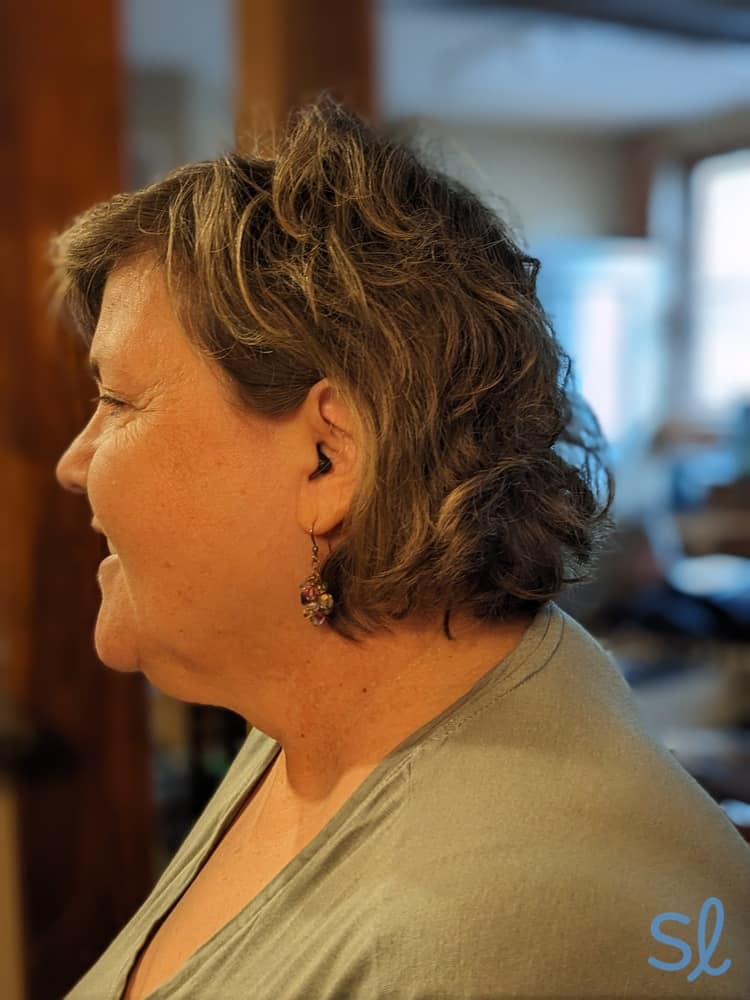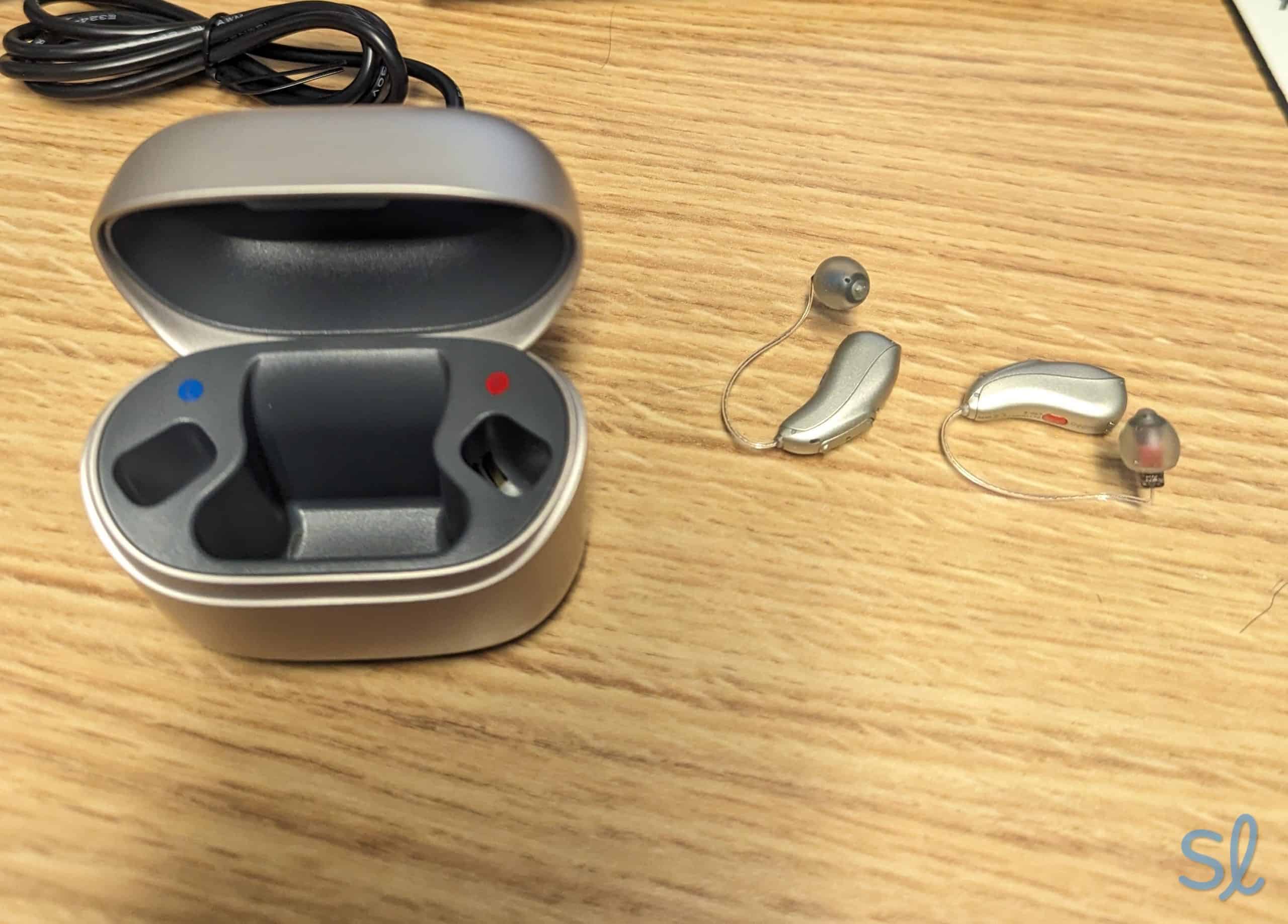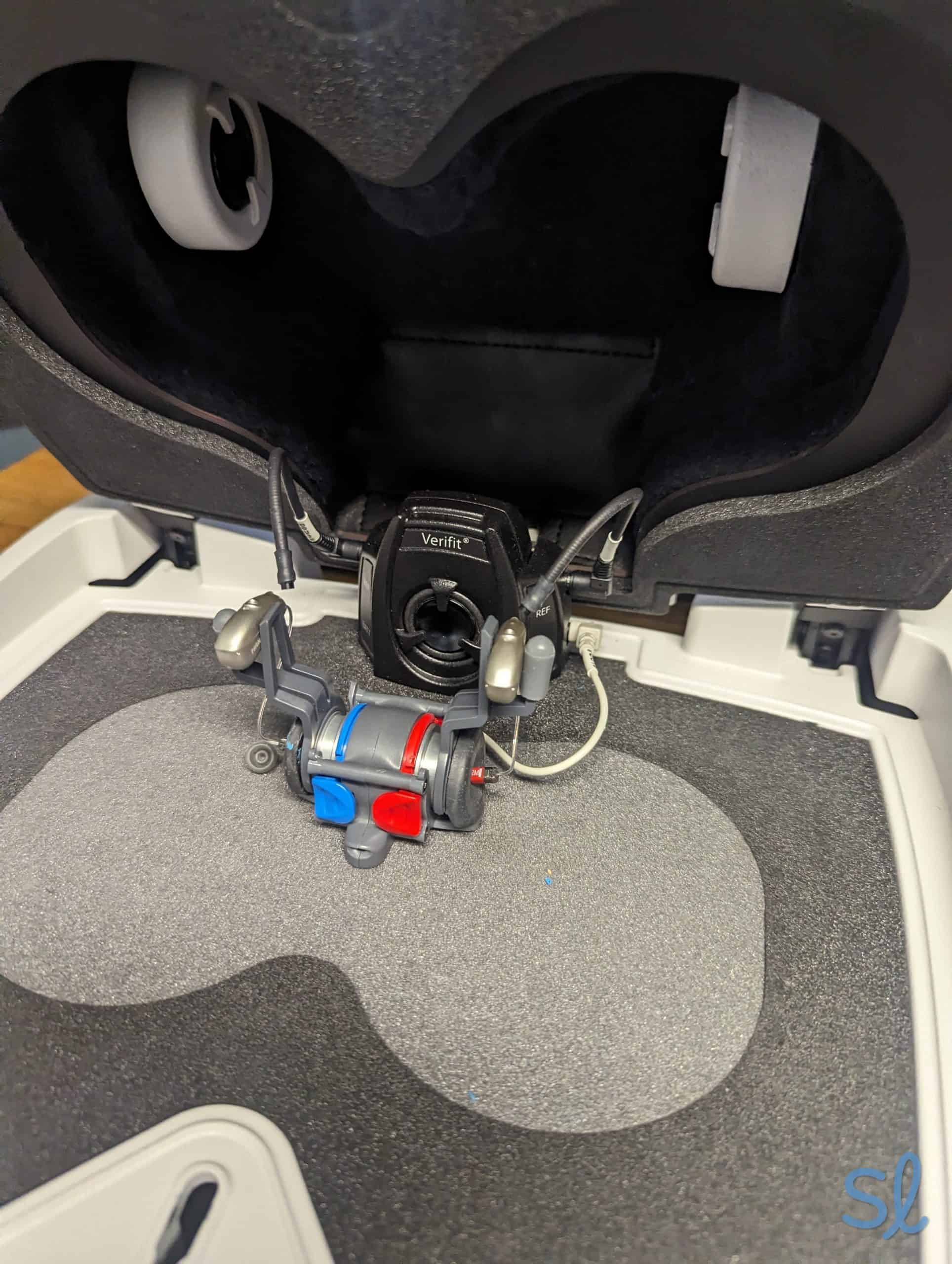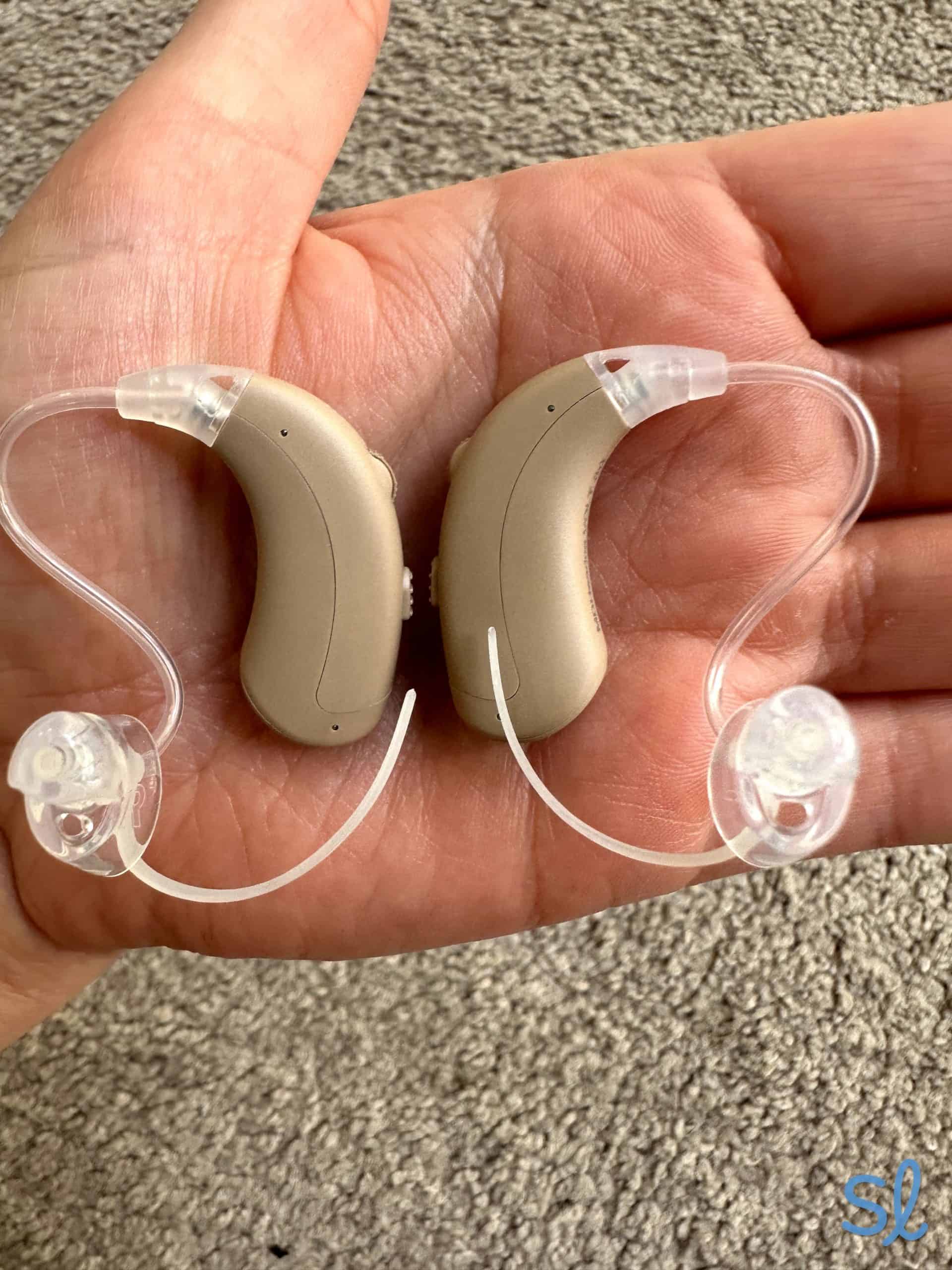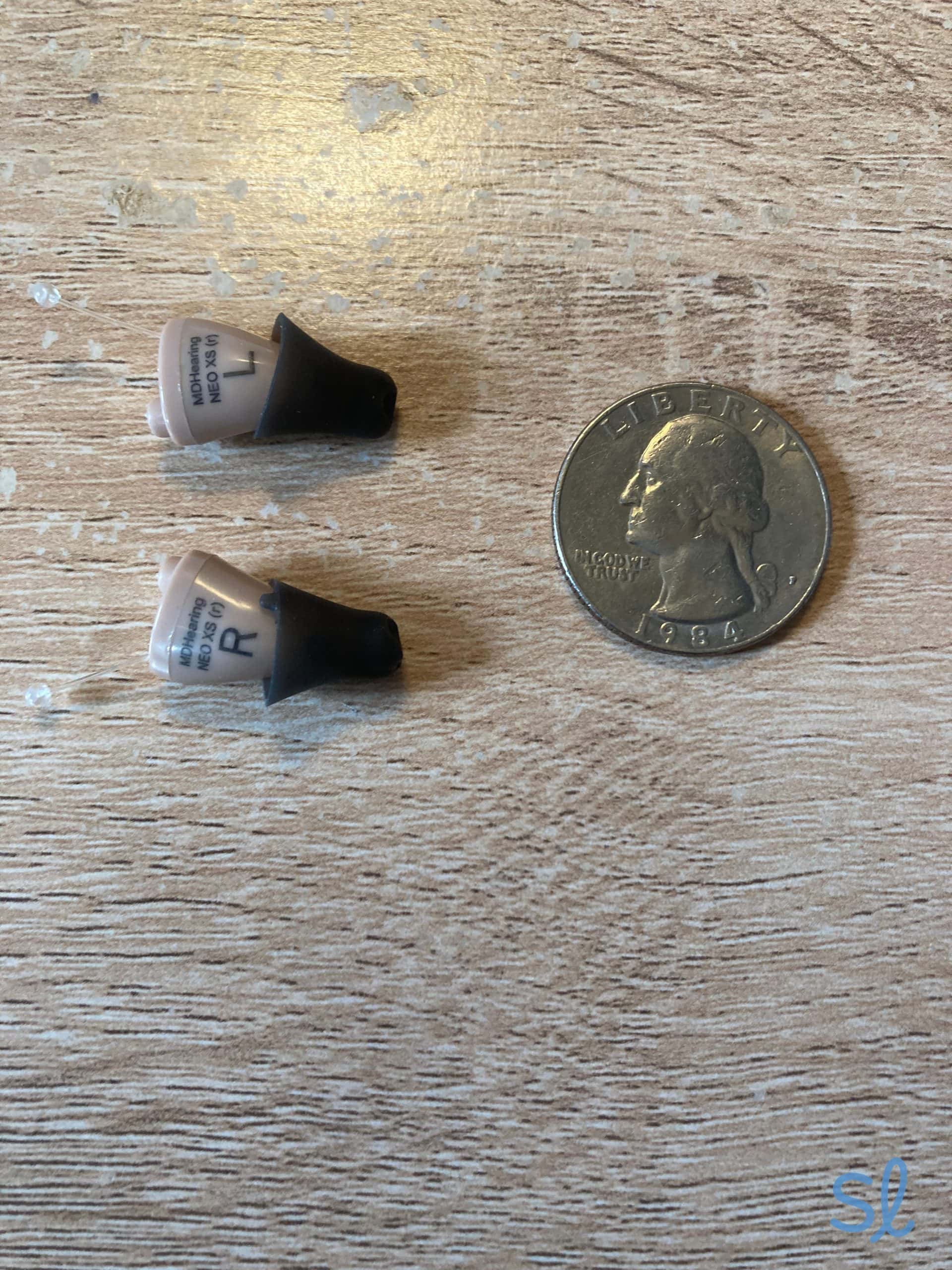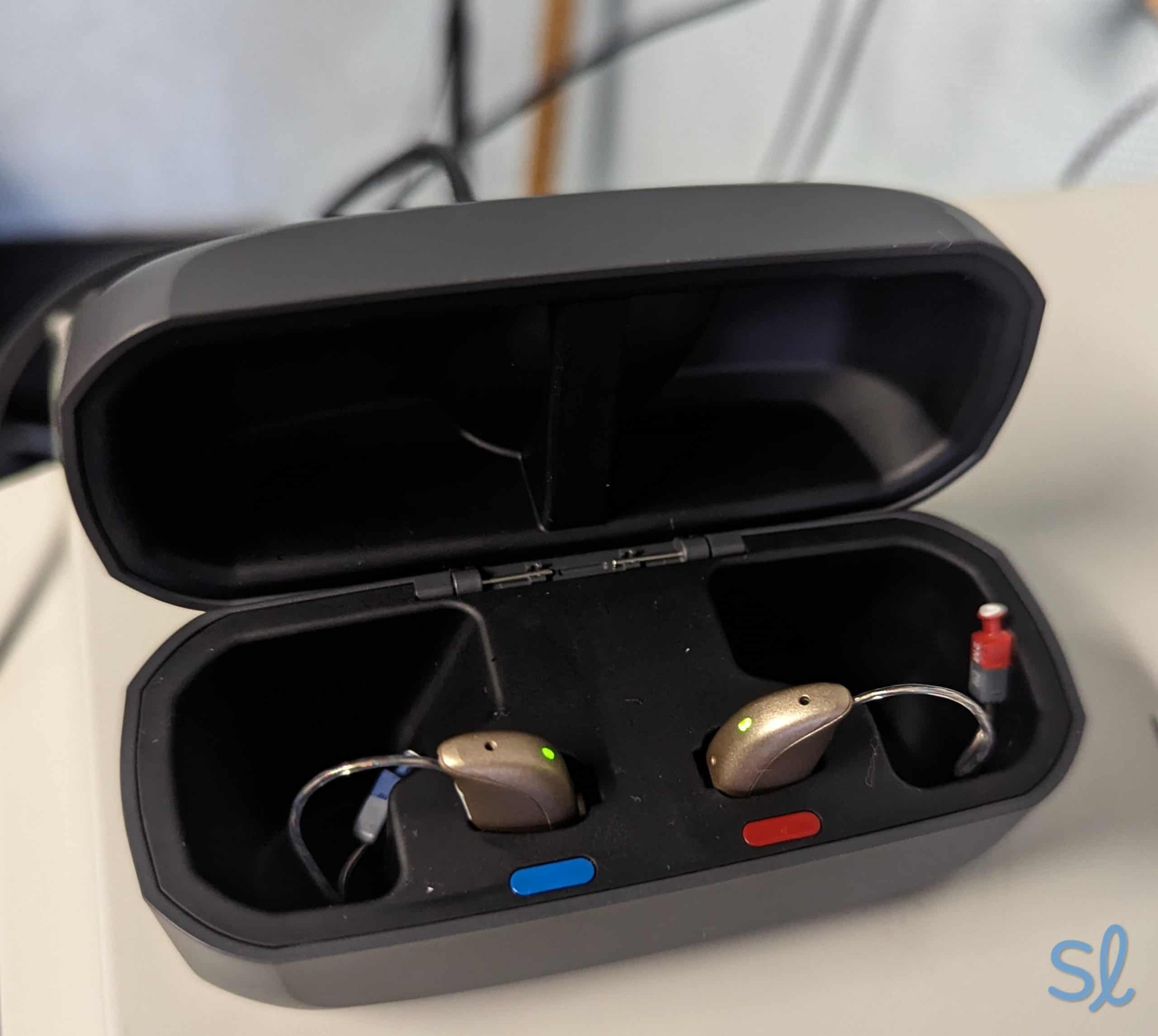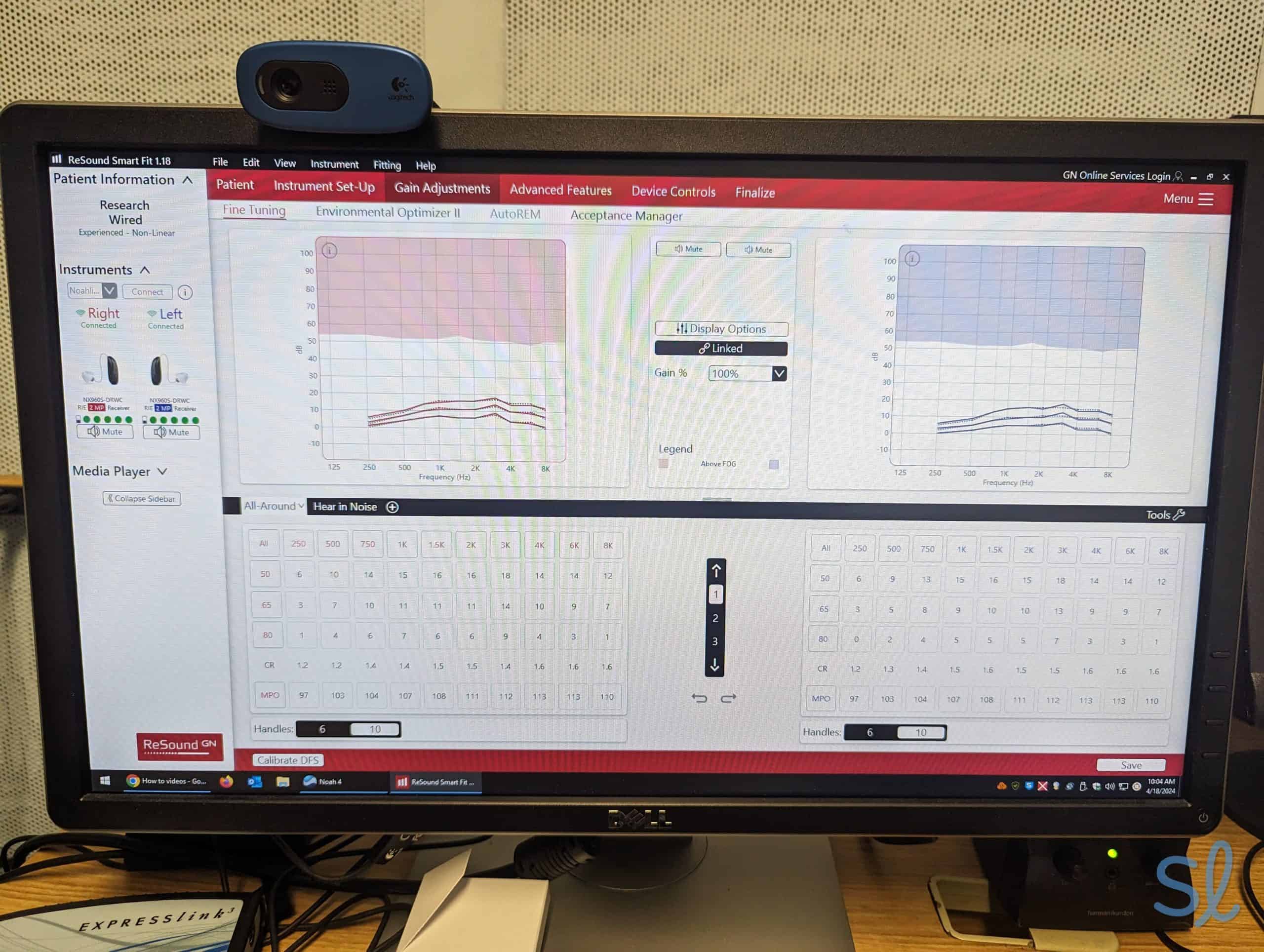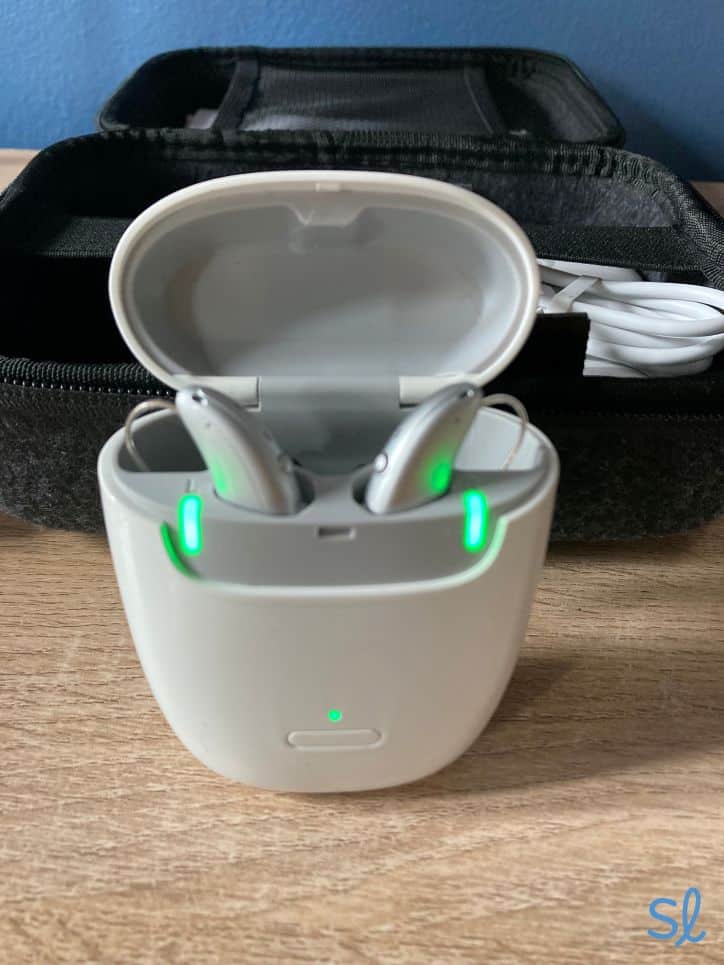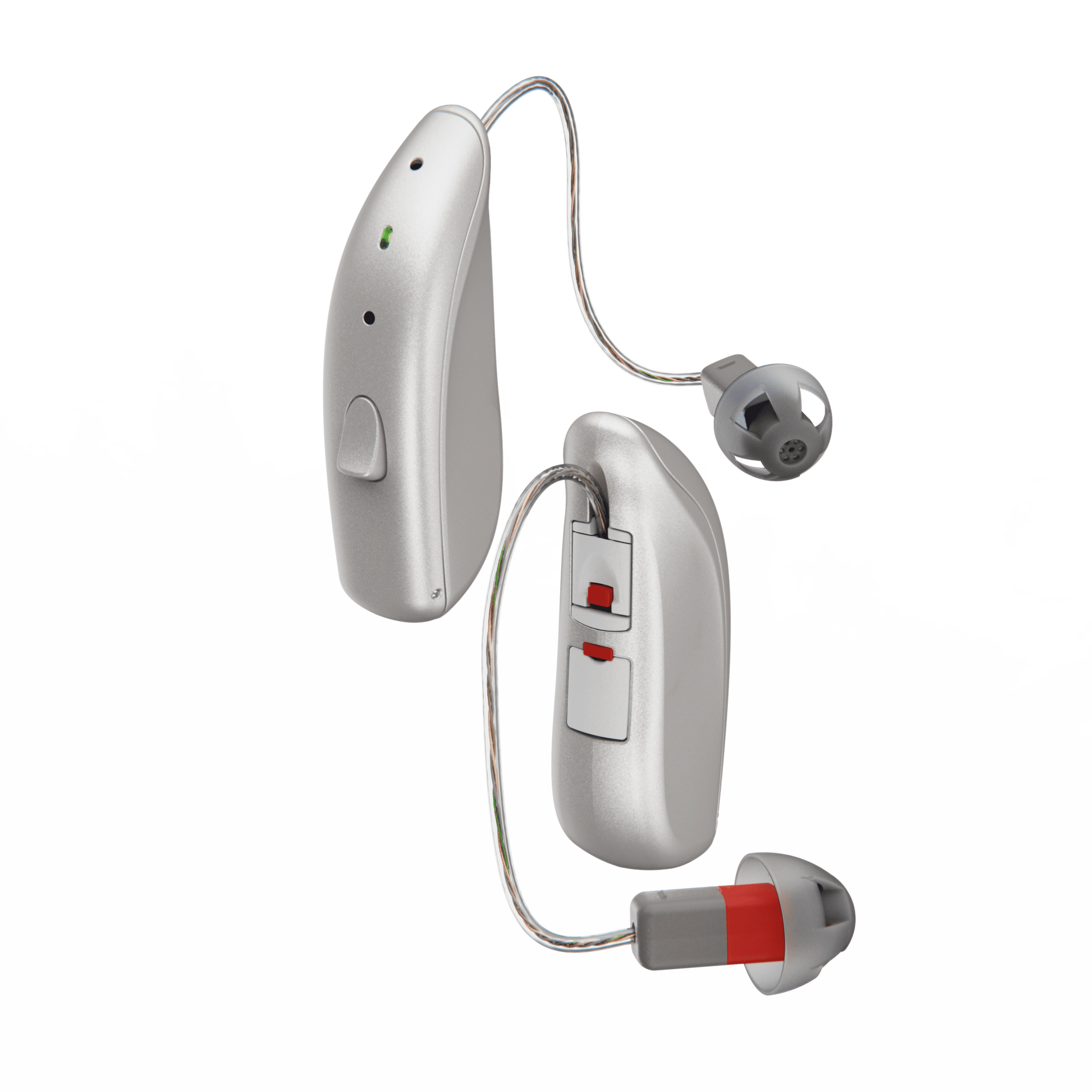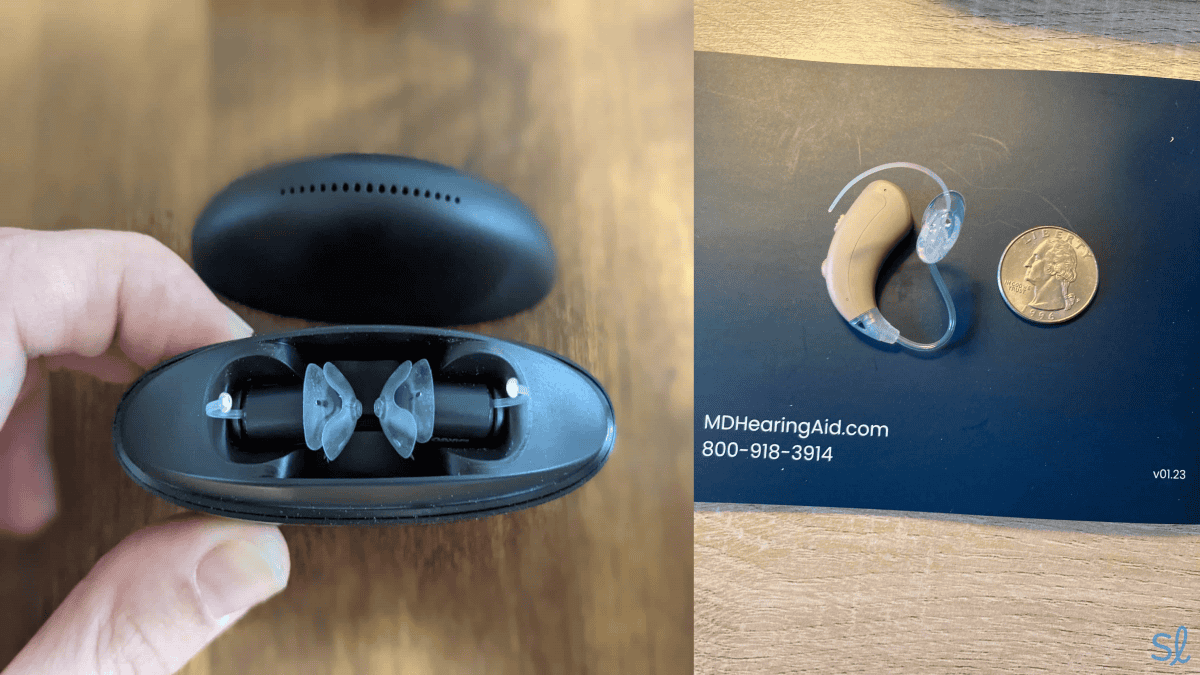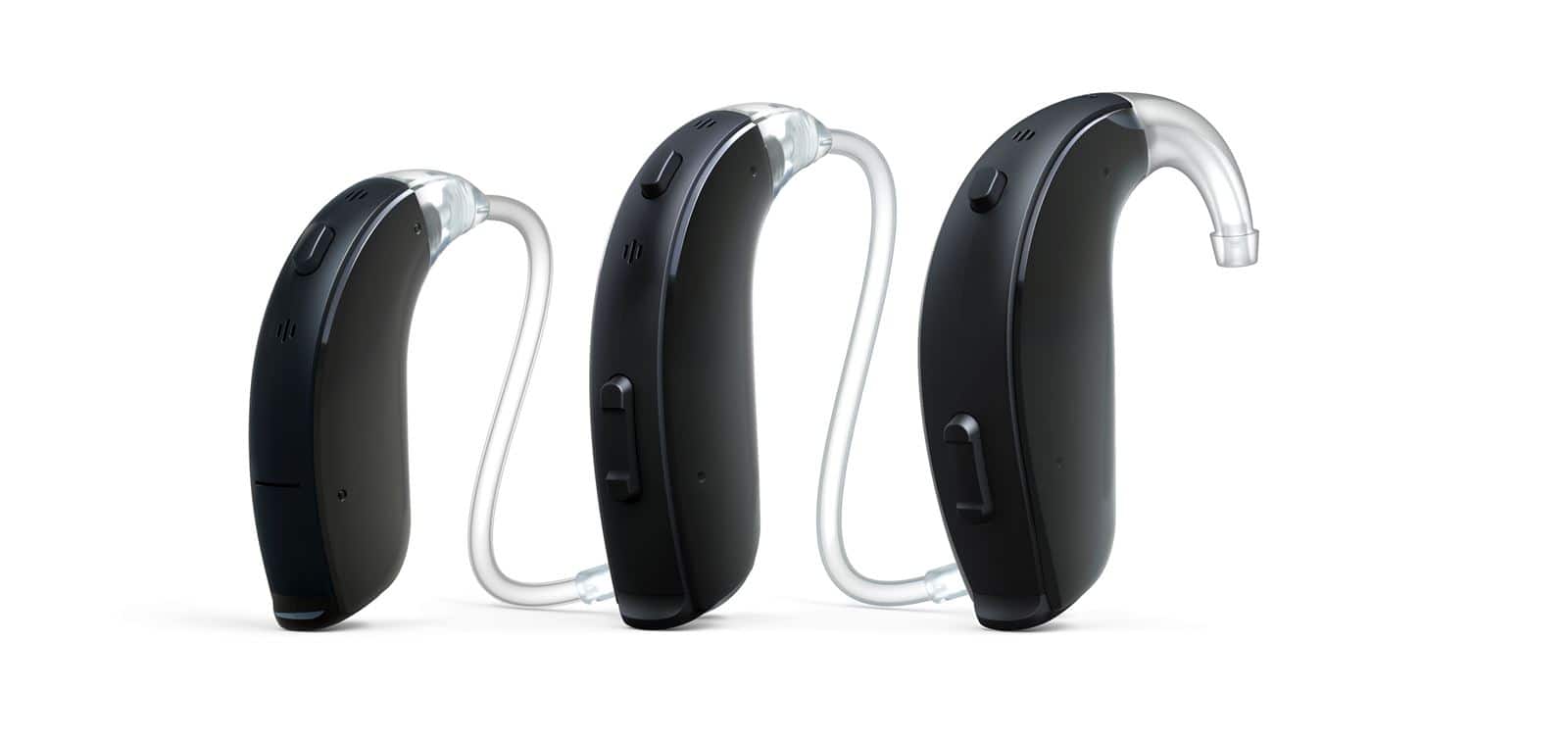Best Hearing Aids, Tested and Reviewed by Audiologists in 2025
Jabra Enhance is our top pick for hearing aids. With prices starting at $995 per pair and excellent follow-up care and sound quality, these OTC hearing aids are hard to beat.
How We Tested the Hearing Aids
Our team of tech experts selected the top-reviewed hearing aids on the market and spent over 100 hours testing them. We focused on all aspects of daily use — from ease of use and comfort to price and battery life.
Here’s what our testing process looked like for OTC hearing aids that could be ordered online:
- We took the online hearing tests offered by each brand, comparing our experiences to in-person evaluations.
- Then, we selected and purchased our hearing aids, taking note of the purchasing process. We considered important factors like the price and overall value.
- Once our devices arrived in the mail, we followed the instructions to get them up and running. If the brand had a mobile app, we set it up as well. We compared each hearing aid based on its ease of use and the number of steps required to start using it.
- Our team spoke with customer service to evaluate the quality of care. We tried various methods, including over the phone, through the mobile app (if applicable), and online chat.
- We tested each hearing aid for a week. We evaluated the hearing aids’ features, sound quality, and ease of use in different environments (at home, restaurants, the park, etc.).
We included several OTC hearing aids on our list, as the high price of prescription hearing aids and difficulty accessing a doctor are two of the main reasons why roughly 20 million Americans with hearing loss don’t seek treatment.
Because prescription hearing aids can’t be ordered online, we turned to our resident expert on the subject, Dr. Ruth Reisman, to learn about her firsthand experience with each brand. We used her experience prescribing and testing each brand, along with feedback from her patients, to evaluate and rank the providers and individual models.
How We Chose the Best Hearing Aids
Throughout our testing process, Dr. Reisman provided insights on her personal experience with the industry’s leading hearing aids to help us build our list. Below are the main factors we evaluated:
- Price and value: We included a mix of affordable hearing aids and premium devices that offer excellent value. OTC hearing aids are more affordable and accessible (you can order them online without a doctor’s appointment), while prescription hearing aids are more expensive and require in-person fittings.
- Follow-up care: We prioritized brands that offer follow-up care with audiologists and hearing experts to ensure you get the most out of your hearing experience for years to come. Every provider on our list offers follow-up care; some providers limit support to “premium” packages only lasting a few years, while others offer lifetime support.
- Technology: We prioritized brands that offer technology to support the best listening experience. This includes features like background noise reduction, speech enhancement, media streaming, invisible designs, rechargeable batteries, and programs designed for different environments.
- Add-on equipment and mobile apps: We evaluated each provider’s add-on equipment, like microphones and media streamers, along with mobile apps. These extra features can enhance the listening experience and add value to your purchase.
Why Trust Us

All of the hearing aids on our list were either tested by our tech experts, dispensed by audiologist Dr. Ruth Reisman and Dr. Brad Ingrao, or both. As a doctor of audiology, Dr. Reisman, AuD MBA CCC-A, has been prescribing and fitting hearing aids for over a decade. Dr. Brad Ingrao has been prescribing hearing aids from dozens of providers since the 1990s. They reviewed and approved all of our top picks. We’ve included their recommendations and opinions throughout this guide.
SeniorLiving.org is supported by commissions from providers listed on our site. Read our Editorial Guidelines
- Prices starting at $1,195 per pair
- Solutions for mild-to-moderate hearing loss
- Over-the-counter hearing aids
- Prices starting at $799 per pair
- Solutions for mild to moderate hearing loss
- Over-the-counter hearing aids
- Prices starting at $3,000 per pair (estimated)
- Solutions for mild-to-profound hearing loss
- Prescription hearing aids
- Competitively priced hearing aids
- 24/7 live customer support
- Available to purchase individually or as a pair
- Options for all levels of hearing loss
- State-of-the-art devices and features
- Custom hearing aids
- Hearing aids for mild to profound hearing loss
- Multiple built-in tinnitus tools
- Easy adjustments in the Signia app
Contents
Finding the right hearing aid can improve your quality of life and help you join in on the conversation more easily! Our team of experts, including audiologists and senior tech authorities, tested and reviewed the industry’s best hearing aids for seniors to help you find the one that’s right for you. Our resident audiologists, Dr. Ruth Reisman and Dr. Brad Ingrao, worked with us to develop this list and have personally tested or prescribed every model below.
There are two types of hearing aids: over-the-counter (OTC) hearing aids and prescription hearing aids that must be purchased in the office. One type might be better suited for your needs than the other, so it’s important to understand the differences. We evaluated the top OTC and prescription hearing aid providers on the market based on price, value, sound quality tech, follow-up care, mobile apps, and more.
The SeniorLiving.org Verdict: Jabra Enhance is our top pick if you're looking for the best OTC hearing aids for mild to moderate hearing loss. You can easily purchase them online, and they have excellent follow-up care.
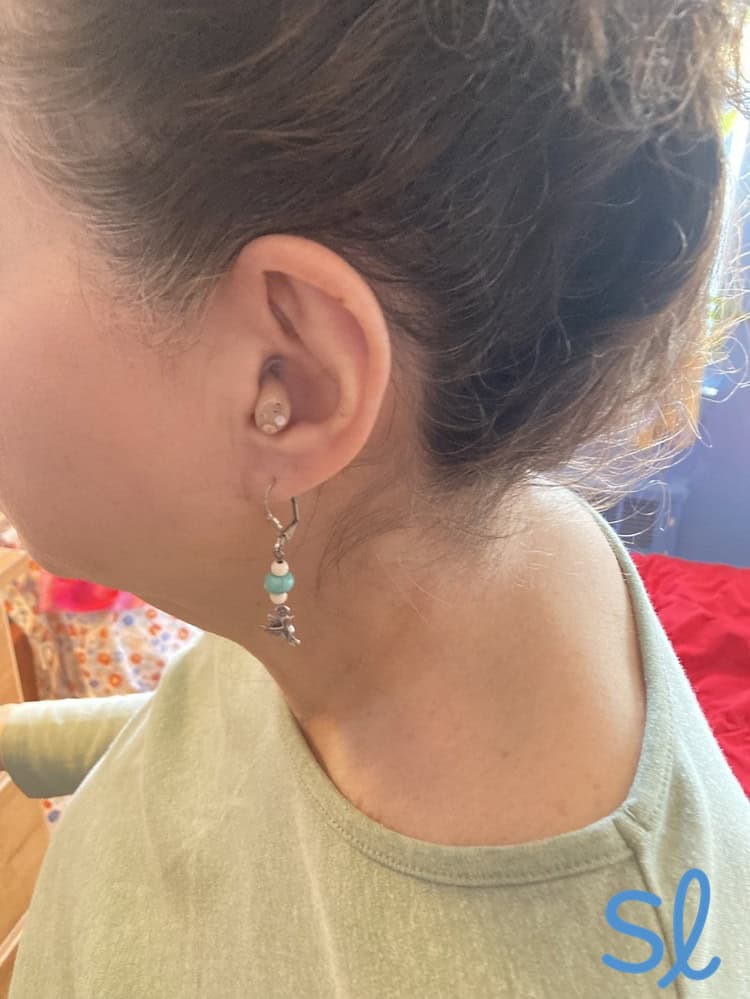
One of our tech experts wearing MDHearings NEO XS PRO hearing aids
Top Hearing Aids for Older Adults, Compared Side by Side
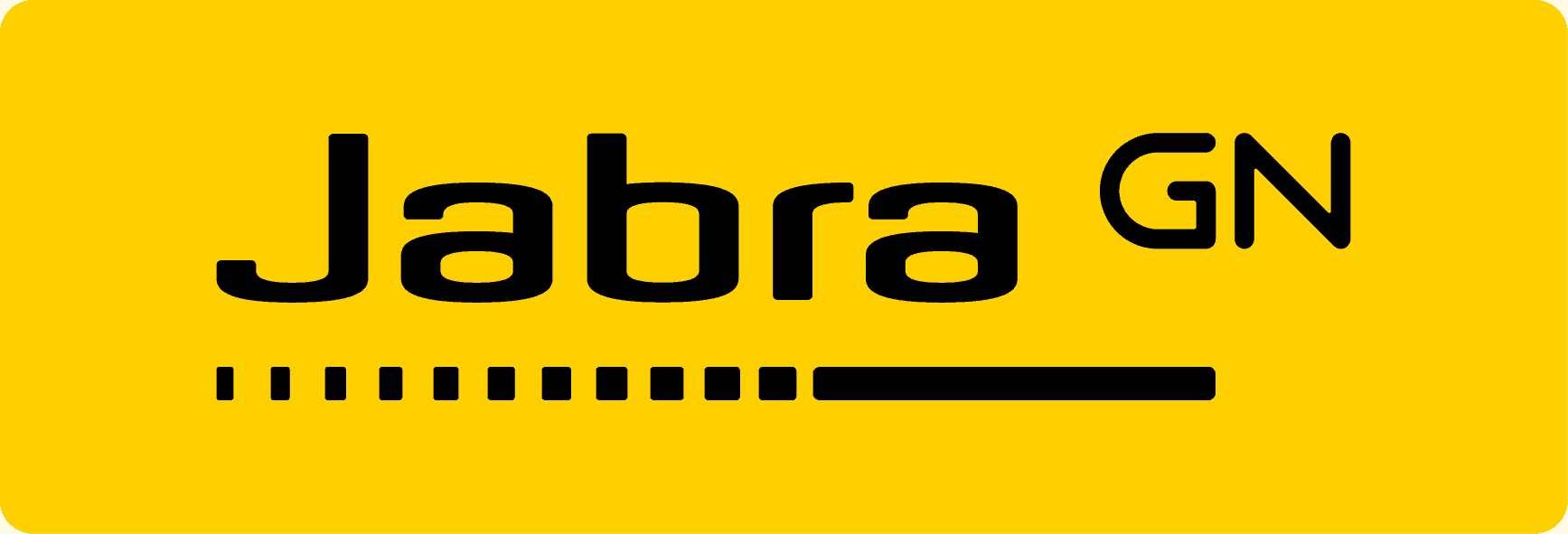
Jabra Enhance
|

Eargo
|

Phonak
|

MDHearing
|
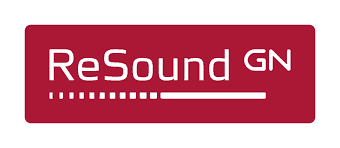
ReSound
|
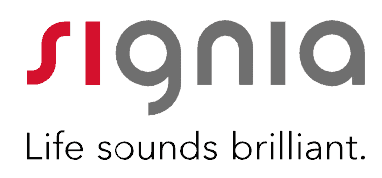
Signia
|
|
|---|---|---|---|---|---|---|
| Rating | 4.8 | 4.5 | 4.4 | 4.4 | 4.4 | 4.6 |
| Hearing loss | Mild to moderate | Mild to moderate | Mild to profound | Mild to moderate | Mild to profound | Mild to profound |
| Price | $1,195 to $1,995 per pair | $799 to $2,699 per pair | Approximately $1,000 to $4,800 per device | $297 to $597 per pair | $1,000 to $2,200 per device | $1,000 to $4,000 per device |
| Purchasing options | Online | Online | In-office, insurance | Online | In-office, insurance | In-office, insurance, prescription required |
| Financing | Yes | Yes | Varies by office | Yes | Varies by office | Varies by office |
| Return option | 100 days | 45 days | 45-90 days | 45 days | 45-90 days | 30 to 60 days |
| Remote support | Yes | Yes | Yes | Yes | Yes | Yes |
| Mobile app | Yes | Yes | Yes | Yes | Yes | Yes |
| Tinnitus features | Yes | No | Yes | No | Yes | Yes |
-
1. Jabra Enhance - Best Value
 See Pricing Links to Jabra Enhance
See Pricing Links to Jabra EnhanceWhat we like most
- Prices starting at $1,195 per pair
- Solutions for mild-to-moderate hearing loss
- Over-the-counter hearing aids
 Jabra EnhanceSee Pricing Links to Jabra EnhanceKey Takeaways:
Jabra EnhanceSee Pricing Links to Jabra EnhanceKey Takeaways:Price: $1,195 to $1,995 per pair
Best for: Mild-to-moderate hearing loss
Purchasing options: Online
Jabra Enhance Select 300 hearing aids
Why They Made Our List
Jabra Enhance, formerly known as Lively, offers the most bang for your buck, thanks to their many features and stellar support. They offer behind-the-ear (BTE) models for different budgets and on-the-go adjustments with the Jabra Enhance Select mobile app. This makes it easy for older adults to manage their hearing settings — tech-savvy or not.
» Related Reading: Best OTC Hearing Aids
The provider lends a helping hand with three years of loss and damage coverage and virtual follow-up care. Plus, you’ll get an industry-leading 100-day risk-free trial. Purchasing a hearing aid is a major investment, so we appreciate this extra time to make a decision. For comparison, Eargo and MDHearing, two other OTC providers on our list, offer a 45-day free trial.
Want to learn more about Jabra Enhance hearing aids and our other top picks from an audiologist? Watch the video below with audiologist Dr. Ruth Reisman and SeniorLiving.org Editor-in-Chief Jeff Hoyt.
Pros & Cons:Pros About Jabra Enhance
- 100-day risk-free trial
- Mobile app to control and customize settings
- Three years of follow-up care with Jabra Enhance’s audiology team
- Three-year loss and damage protection
Cons About Jabra Enhance
- Must have a compatible smartphone or tablet to use
- Not suitable for severe or profound hearing loss
- Only BTE models available
Our Hands-on Experience:Our Experience With Jabra Enhance
Tested by: Corey Whelan
We tested the Enhance Select 300 model. We were impressed with the Jabra Enhance Audiology Team and the mobile app’s on-demand care and adjustments. We made a Zoom appointment with Dr. Dena Franciotti, Au.D., from the Audiology Team to set up our devices.
The only drawback is that you can’t get in-person assistance. Prescription hearing aids like Phonak and ReSound offer in-person support, which may be more ideal for older adults who are not comfortable using an app to make hearing aid adjustments. That said, Jabra Enhance still offers some of the best hearing aids for seniors who prefer the ease and affordability of OTC devices.
We wore our hearing aids for a walk and noticed that the sound quality on a busy city street was clear and natural. There was no whiny feedback noise or humming sounds. Plus, we could quickly change the program using a button on the hearing aids or in the mobile app. We appreciate this app, as some OTC providers, such as MDHearing, don’t offer one with most models. See our Jabra Enhance Review to learn more.
Making adjustments using the Jabra Enhance mobile app
Pricing
- Enhance Select 50R: $1,195 per pair
- Enhance Select 300: $1,695 per pair
- Enhance Select 500: $1,995 per pair
Jabra Enhance hearing aids cost $1,195 to $1,995 per pair. Until recently, you could get all models in a Basic or Premium package. Now, Jabra Enhance has eliminated the Basic option, which means that seniors won’t have the option to save $200 on the simpler package.
Although it’s now the only option, we’ve always recommended the Premium package anyway, as it includes three years of follow-up care and loss and damage protection. Seniors can definitely benefit from having remote audiologist support, especially as they get adjusted to their new hearing devices.
And when compared to leading providers like Phonak and ReSound, the Premium package is still very affordable. That said, there are a few cheaper OTC providers, including MDHearing, with prices starting at $297 per pair.
The Verdict From an Audiologist
Expert InsightsFrom Dr. Ruth Reisman, AudiologistJabra Enhance devices, particularly the Jabra Enhance 500, provide an array of benefits, including tinnitus management and hearing loss treatment. With superior sound quality, seamless connectivity, innovative design, advanced noise cancellation, and versatile applications, Jabra consistently delivers exceptional audio solutions that enhance productivity, entertainment, and communication clarity. However, those who require additional support may need to consider alternate options since the hearing aids are locked and cannot be programmed by an alternate professional.» Learn More: Best Hearing Aids for Tinnitus in 2025
-
2. Eargo - Most Discreet
 See Pricing Links to Eargo
See Pricing Links to EargoWhat we like most
- Prices starting at $799 per pair
- Solutions for mild to moderate hearing loss
- Over-the-counter hearing aids
 EargoSee Pricing Links to EargoKey Takeaways:
EargoSee Pricing Links to EargoKey Takeaways:Price: $799 to $2,699 per pair
Best for: Mild-to-moderate hearing loss
Purchasing options: Online
Testing out the Eargo 8
Why They Made Our List
Eargo offers discreet, completely-in-canal (CIC) devices. Compared to a BTE hearing aid, CIC devices fit inside the ear and are nearly invisible to others. Having more discreet hearing aids is ideal for seniors who need them but don’t want their hearing devices to be obvious to everyone else.
The Eargo 8 features the company’s most advanced noise reduction and a self-fitting feature for a personalized listening experience. Eargo also offers the LINK, an earbud-style hearing aid for those who want something different from traditional hearing aid styles. The company offers a 45-day trial period, so you can see if these devices are right for you.
» Related Reading: 2025 Eargo Review
Pros & Cons:Pros About Eargo
- Virtually invisible design
- Financing for 12, 24, or 36 months
- Sound Adjust feature automatically optimizes soundscape
- One-time loss/damage coverage per unit
- Lifetime remote support from hearing professionals
Cons About Eargo
- Not designed for severe-to-profound hearing loss
- Must have a smartphone to use
- May not fit everyone due to different ear canal shapes and anatomy
Our Hands-on Experience:Our Experience With Eargo
Tested by: Sarah Goldy-Brown
We tested the provider’s most advanced model, the Eargo 8. Wearing both devices felt uncomfortable, even a bit painful, in our small ears. While Eargo devices come with a few different petal sizes to accommodate different ear shapes, the company notes that its devices aren’t right for everyone’s ear shape.
However, one of our testers had her mom try Eargo’s devices, and she didn’t experience any pain. Luckily, Eargo offers a free fit-and-feel sample, which includes a non-functioning replica of their hearing aids to test. We think this is perfect for seniors who are new to wearing hearing aids and would like to take them for a “test drive” before making a purchase.
Eargo's hearing aids are nearly invisible.
Pricing
- LINK by Eargo: $799
- Eargo SE: $1,699
- Eargo 8: $2,699
Eargo’s prices range from $799 per pair to $2,699 per pair. These starting prices are about $300 less than Jabra Enhance’s most affordable option, but around $500 more than MDHearing’s cheapest models. Eargo’s prices for premium products, like the Eargo 8, are much higher than similar options from other OTC brands.
» You Might Like: Discounts for Seniors
The Verdict From an Audiologist
Expert InsightsFrom Dr. Ruth Reisman, AudiologistEargo hearing aids are an innovation in the hearing aid arena. Their unique design, features, and customer service model have allowed for true evolution in the fitting of direct-to-consumer hearing aids. Just like most devices for those who are candidates, it seems performance and satisfaction are very high for Eargo hearing aids. However, those who are not ideal candidates still tend to struggle. If discretion is very important to you, Eargo hearing aids are certainly worth a try.*Dr. Reisman highly recommends a medical evaluation before fully inserting CIC devices into the ear.
-
3. Phonak - Best for Severe to Profound Hearing Loss
 See Pricing Links to ZipHearing.com
See Pricing Links to ZipHearing.comWhat we like most
- Prices starting at $3,000 per pair (estimated)
- Solutions for mild-to-profound hearing loss
- Prescription hearing aids
 PhonakSee Pricing Links to ZipHearing.comKey Takeaways:
PhonakSee Pricing Links to ZipHearing.comKey Takeaways:Price: Approximately $1,000 to $4,800 per device
Best for: Mild to profound hearing loss
Purchasing options: In-office, insurance, prescription required
Testing out Phonak hearing aids
Why They Made Our List
OTC brands like Eargo and MDHearing are only appropriate for mild to moderate hearing loss. Phonak, on the other hand, offers prescription solutions for all hearing loss levels, from mild to profound, including one of the only solutions for those with very significant loss. Since hearing loss worsens over time for many seniors, this is a huge plus. For that reason, it’s our top pick for severe to profound hearing loss.
Did You Know? More than half of workers regularly exposed to noise at their jobs do not wear hearing protection, potentially worsening or accelerating their hearing loss.1
A standout feature is Phonak’s integrated microphone, which offers Bluetooth streaming for hands-free phone calls. Phonak’s prices may put a dent in your wallet when compared to OTC brands like MDHearing, but if you have room in your budget, the brand is certainly worth considering.
» You Might Like: Best BTE Hearing Aids
Pros & Cons:Pros About Phonak
- Best in class for severe-to-profound hearing loss
- Dynamic noise cancellation
- Motion sensor and built-in microphone for hands-free calling
- Long-lasting battery with quick charge
- Direct streaming devices to improve communication
Cons About Phonak
- Higher price point
- Model pricing not provided on website
- Can be bought only through a local provider
Our Hands-on Experience:Our Experience With Phonak
Tested by: Dr. Reisman and Dr. Ingrao
Our resident audiologists, Dr. Reisman and Dr. Brad Ingrao, have been prescribing Phonak hearing aids for decades. In fact, Dr. Ingrao estimates that he fits at least 75 percent of his patients with Phonak hearing aids.
The company’s lineup includes powerful BTE hearing aids like the Naída Lumity line and the Lyric, a completely invisible extended-wear device. Another one of our favorite models, the Audéo Lumity, uses AI technology to automatically adjust to your sound environment. You can read our full Phonak review to learn more about our experience with this brand.
» Related Reading: Best Hearing Aids for Severe Hearing Loss
Dr. Reisman uses Verifit equipment to test Phonak hearing aids and ensure the best experience for her patients
Pricing
Like other prescription hearing aids, Phonak does not list prices online, which is one of the drawbacks of medical-grade hearing aids. To get pricing information, you’ll need to visit a local hearing care provider that sells Phonak devices. Also note that prices are not standard and will vary by location.
FYI: You’ll need to ask your hearing care provider about specific deals they offer, but you may be able to get $200 off (or more) by searching for a participating provider online.
Dr. Reisman estimates that Phonak hearing aids typically cost between $1,000 and $4,800 per ear, on average. These prices are typical for prescription hearing aids, but they are much higher than OTC hearing aids. For example, Jabra Enhance’s most expensive model, the Enhance Select 700, starts at $1,995 per pair, while Phonak hearing aids could cost even more than that per ear.
» Also Check Out: Best Hearing Aids for Single-Sided Hearing Loss
The Verdict From an Audiologist
Expert InsightsFrom Dr. Ruth Reisman, AudiologistThese devices are often the only option for individuals with very significant hearing loss. Not only is there sufficient gain, but it also has all the advanced options of other Phonak hearing aids, including Bluetooth, hands-free calls, and Roger wireless microphone compatibility for supporting seamless communication in all environments. For individuals with severe losses, this can significantly improve their quality of life. -
4. MDHearing - Most Affordable
See Pricing Links to MDHearingWhat we like most
- Competitively priced hearing aids
- 24/7 live customer support
- Available to purchase individually or as a pair
MDHearingSee Pricing Links to MDHearingKey Takeaways:Price: $297 to $597 per pair
Best for: Mild to- moderate hearing loss
Purchasing options: Online
Testing out MDHearing's VOLT devices
Why They Made Our List
If you’re on a tight budget, MDHearing is our top pick. This company offers the most affordable hearing aids on our list, starting at $297 per pair, after sales and discounts. MDHearing devices can be purchased online, like hearing aids from Eargo and Jabra Enhance. Their lineup includes three BTE options and three in-the-ear (ITE) models for mild to moderate hearing loss. MDHearing devices are designed to be simple, but they still include the most important features like noise reduction, feedback cancellation, and adjustable settings.
MDHearing’s 24/7 support by phone or email assists customers throughout their hearing aid experience. You can connect with MDHearing’s in-house audiologists for customized recommendations based on your online hearing test results. Unlike Jabra Enhance, which limits its follow-up care to three years, MDHearing provides lifetime support at no extra cost (a huge plus for us).
» Learn More: MDHearing Review
Pros & Cons:Pros About MDHearing
- 24/7 lifetime support by phone or email
- Affordable financing options
- Available individually or as a pair
- Four sound environment settings
- Feedback cancellation
Cons About MDHearing
- Beige is the only color available
- Not suitable for severe-to-profound hearing loss
- No companion mobile app
Our Hands-on Experience:Our Experience With MDHearing
Tested by: Corey Whelan
We tested MDHearing’s NEO XS, which is an in-ear model designed to be more discreet than their three BTE models. We have small ear canals and were surprised by how much of the hearing aid stuck out, since it was designed for minimal visibility. After speaking with customer service, we tried smaller-sized domes, but we struggled to get them on and off.
Testing out the Neo XS from MDHearing
Again, this is a drawback with OTC hearing aids. There’s no in-person support, so you have to figure things out on your own. Luckily, after a few tries, we got the smaller domes on. The sound was clear and crisp across all channels.
Expert InsightsFrom Audiologist Dr. Ruth Reisman,Sound quality can change depending on the ear dome used. If you would like to retain more sound- and noise-management benefits, try more closed domes.We wish MDHearing had a mobile app for remote adjustments, like Jabra Enhance does. An app can make changing hearing aid settings easier for seniors with dexterity issues like arthritis. However, we found that the settings were simple to adjust using the device’s buttons.
» Learn About: Best Hearing Aids for Active Lifestyles
Pricing
- AIR: $297 per pair
- NEO: $297 per pair
- VOLT: $397 per pair
- NEO XS: $297 per pair
- VOLT MAX: $597 per pair
- NEO XS PRO: $597 per pair
MDHearing’s models range from $297 to $597 per pair. Though the company lists higher “standard” prices before discounts, we’ve never found a time when the devices weren’t on sale.
These starting prices are around $900 less than Jabra Enhance’s prices. Just remember that MDHearing keeps things very simple. It doesn’t offer a mobile app for most models or follow-up care like Jabra Enhance does. That said, they’re a great fit for seniors on a fixed income who struggle with mild to moderate hearing loss.
» Related Reading: Hearing Aid Cost Guide
The Verdict From an Audiologist
Patients report that the MDHearing VOLT is easy to set up and get started, but they cannot get support readily, especially if they are outside of the U.S. If the volume feels too loud or you’re experiencing feedback with your MDHearing devices, this may be due to overamplification. Reducing the volume with the manual buttons may relieve both issues and help preserve your residual hearing. -
5. ReSound - Best Rechargeable Device and Telehealth Support
See Pricing Links to ZipHearing.comWhat we like most
- Options for all levels of hearing loss
- State-of-the-art devices and features
- Custom hearing aids
ReSoundSee Pricing Links to ZipHearing.comKey Takeaways:Price: $1,000 to $2,200 per device
Best for: Mild to profound hearing loss
Purchasing options: In-office, insurance, prescription required
Testing out ReSound hearing aids
Why They Made Our List
ReSound offers innovative and durable hearing aids for all levels of hearing loss. ReSound’s rechargeable models eliminate the need to replace batteries, perfect for those with dexterity issues. The ReSound Nexia style delivers a full day of use (up to 24 hours on just one charge). ReSound is also the only brand with a three-microphone system (on select models). This helps restore natural hearing by using the outer ear.
Through the ReSound Assist Live mobile app, your hearing care professional can make real-time adjustments and fine-tune your hearing aids while you’re at home. Though you’ll need an in-person hearing assessment and fitting, this telehealth support can help reduce your office visits over time.
Pros & Cons:Pros About ReSound
- State-of-the-art devices, accessories, and smartphone apps
- Remote care via Assist Live app
- 360-degree surround sound
- Three-microphone system to restore natural hearing
- Hands-free calls
Cons About ReSound
- Telehealth sessions may be challenging for non-tech-savvy users
- Not available for online purchase
- Pricing not listed on the website
Our Hands-on Experience:Our Experience With ReSound
Tested by: Dr. Reisman and Dr. Ingrao
Our audiologists often recommend ReSound hearing aids to their patients, and it’s one of Dr. Ingrao’s go-to brands. He often recommends ReSound for those who want Android- or iPhone-compatible hearing aids, or accessories to enhance hearing aids, including remote microphones and media streamers. ReSound has several styles of hearing aids, including BTE, ITE, and custom models.
Pro Tip: To learn more about Dr. Ingrao’s experience with this brand, read our latest ReSound review.
Similar to Phonak, ReSound has advanced features that OTC brands like Jabra Enhance don’t offer. For instance, the inclusion of a third microphone on select models, like Nexia, enhances natural sound quality. ReSound’s technology also reduces listening effort in areas with lots of background noise. In the image below, Dr. Reisman is testing and fine-tuning a pair of ReSound hearing aids.
Testing and fine-tuning ReSound hearing aids
Pricing
Similar to Phonak, ReSound doesn’t list prices online. Prices will vary based on location and hearing aid. Dr. Reisman estimates that ReSound hearing aids cost $1,000 to $2,200 per ear, placing them in the same ballpark as Phonak.
Again, budget-friendly OTC providers like MDHearing and Eargo are a few thousand dollars cheaper than ReSound. However, OTC hearing aids aren’t suitable for severe to profound hearing loss, and they don’t offer the same level of customization or advanced features.
» Related Reading: Best Cheap Hearing Aids
The Verdict From an Audiologist
Expert InsightsFrom Dr. Ruth Reisman, AudiologistReSound Nexia is a great device, particularly for patients with a cochlear implant in the opposite ear. Its connectivity options for Android devices, for Apple devices, and in various public places are the most expansive of all hearing aid technology. It offers many advantages for those with hearing loss, including a third microphone in the ear to enhance natural sound quality, better hearing in noisy environments, and enhanced connectivity options with Auracast. -
6. Signia - Best Tinnitus Solutions
See Pricing Links to ZipHearing.comWhat we like most
- Hearing aids for mild to profound hearing loss
- Multiple built-in tinnitus tools
- Easy adjustments in the Signia app
SigniaSee Pricing Links to ZipHearing.comKey Takeaways:Price: $1,000 to $4,000 per device
Best for: Mild to profound hearing loss
Purchasing options: In-office, insurance, prescription required
Charging our Signia Pure Charge&Go devices
Why They Made Our List
Signia stands out for tinnitus relief because they pair masking sounds (soft static and ocean-wave programs) with Notch Therapy, an approach tailored to tonal tinnitus that works quietly in the background while you wear the hearing aids. Dr. Brad Ingrao highlights Signia’s tinnitus toolkit, and the brand’s IX products are available in multiple sizes and forms, so users don’t have to trade style for symptom control.
The brand consistently delivers dependable hardware with sophisticated signal processing. Their lithium-ion batteries hold up well against real-world wear and tear, and the 2.4 GHz connectivity enhances accessories and app controls. Add in reliable direct streaming to mobile devices, and you get a tinnitus-friendly system that fits perfectly with older smartphone users.
» Our Full Review: Signia Hearing Aid Review
Pros & Cons:Pros About Signia
- Robust tinnitus features
- Slim, discreet designs
- Helpful app with quick fine-tuning and wellness insights
- For mild to profound hearing loss
Cons About Signia
- Requires a prescription
- Pricing tends to be higher
- Trial length, warranty terms, and pricing varies by provider
Our Hands-on Experience:Our Experience With Signia
Tested by: Dr. Reisman and Dr. Ingrao
In our audiologists’ experience with the Pure Charge&Go IX (and others in the IX lineup), they report strong battery life, easy programming, and effective tinnitus tools. The Notch Therapy feature, in particular, has proven to be a highly effective way to subdue the ringing sounds that those with tinnitus often experience.
The Signia app also pairs quickly and lets users adjust programs or let AI-driven tech determine the best programmation for the user and specific environment.
Pricing
Like other prescription hearing aids, Signia’s pricing is not published online and can vary from one provider to the next. That said, Dr. Reisman estimates that starting costs are around $1,000 per device and can range up to $4,000 per device.
Expect to purchase your Signia hearing aids through a local hearing-care professional. Many clinics offer trial windows and service bundles, though these will also vary based on your location, the model you choose, and the local clinician.
The Verdict From an Audiologist
Expert InsightsFrom Dr. Ruth Reisman, AudiologistSignia is my favorite hearing aid brand because of the unique and advanced technology tools offered. Their cutting-edge Own Voice Processing (OVP) makes users' voices sound more natural and their AI-powered Signia Assistant offers real-time support and personalized adjustments.
The Runners-Up
We’ve tested dozens of brands to find the best hearing aids for seniors with a variety of needs. Some providers almost made the cut, but fell a little short of the mark. Here are our top runners-up for the best hearing aid for older adults.
- Starkey: A tech-forward prescription brand with custom-fit options, AI features, and health tools like activity tracking and fall detection. Starkey is great for seniors who want advanced capabilities in a discreet package, albeit at a relatively high price point. Learn more in our Starkey review.
- Audien: A budget-friendly, easy-to-use OTC brand for seniors with mild to moderate hearing loss, but with fewer customization and support features than pricier brands. See performance notes and more in our hands-on Audien review.
- Lexie: Another OTC option for those with mild to moderate hearing loss, Lexie offers an app-based hearing test, at-home setup, and flexible payment options. Compare models and pricing in our Lexie review.
The Best Hearing Aids for Every Need

The chart below will guide you through some of the best hearing aids for seniors, based on your needs and goals.
| I want to | Best hearing aid option |
|---|---|
| Enhance speech understanding | Once amplified appropriately, speech understanding should improve with all hearing aids.
Best OTC option: Eargo Best in-office option: Phonak |
| Benefit from Bluetooth connectivity and an app for adjustments | Many hearing aids have Bluetooth direct audio streaming. Some also include remote adjustments through an app.
Best OTC option: Jabra Enhance Best in-office option: ReSound |
| Hear better in background noise and social settings | Almost all hearing aids will use some form of noise management or have directional microphones to help decrease background noise.
Best OTC option: MDHearing Best in-office option: Oticon |
| Hear soft voices | All hearing aids have digital processing to help enhance soft sounds. To ensure proper amplification, it’s best to do some form of formal verification with an audiologist.
Best OTC option: Eargo Best in-office option: Phonak |
| Improve tinnitus | Tinnitus and hearing loss often go hand in hand. Several hearing aids include tinnitus management features.
Best OTC option: Jabra Enhance Best in-office options: Widex |
| Enjoy music again | Hearing aids with a sound-adjust feature or intelligent sound automation combat music distortion and create an enjoyable listening experience.
Best OTC option: Eargo Best in-office option: Widex |
| Reduce waste with rechargeable batteries | Rechargeable hearing aids provide all-day use, with some aids lasting up to 30 hours.
Best OTC option: Jabra Enhance Best in-office option: ReSound |
| Have a cosmetic appeal | CIC custom hearing aids deliver discreet hearing support.
Best OTC option: Eargo invisible CIC Best in-office option: Starkey CIC |
| Get a great value for my investment | Key features in value include affordability, warranty, and professional support.
Best OTC option: Jabra Enhance Best in-office option: Phonak |
| Receive continuous hearing loss support | All hearing aids have some form of support.
Best OTC option: Jabra Enhance Best in-office option: ReSound |
Did You Know? The rapid advancement of hearing aid tech could take these devices beyond the realm of hearing loss treatment and potentially aid in the advancement of virtual reality and mobile health technology.2
Tips for Testing and Fine-Tuning Your New Hearing Aids From an Audiologist
Be patient with yourself as you learn how to use your hearing aids, as there will be an adjustment period. Here are Dr. Reisman’s top five tips for maximizing your success with your hearing aids:
- Understand how the hearing aid functions and how to clean and maintain the device properly. This ensures that the microphones and receivers don’t get clogged.
- Evaluate whether the hearing aid meets your hearing goals. Keeping a journal in which you note your progress can help with this.
- Wear your hearing aids consistently during all waking hours, as every moment is an opportunity for hearing and listening. If you’re not ready for full-time wear at the start, build up to that goal.
- Establish a hearing rehabilitation program. Ideally, this is done with a hearing health professional, but it can also be done online with programs like LACE and Amptify. Take 10 to 15 minutes each day to test your hearing without any visual cues.
- Assess your success with your hearing aids regularly, and schedule an annual hearing loss checkup.
Pro Tip: If a loved one who needs hearing aids is struggling with Alzheimer’s or another form of dementia, check out our guide to the best hearing aids for Alzheimer’s patients.
Frequently Asked Questions About Hearing Aids
-
What brand of hearing aid is best for seniors?
We think the three OTC models from Jabra Enhance are the best hearing aids for seniors with mild to moderate hearing loss. That said, the right hearing aid model for you will depend on your specific needs. Patients can schedule a virtual consultation with audiologists like Dr. Reisman to help navigate the best hearing solution to fit their needs.
-
Does Medicare cover hearing aids?
No, Medicare doesn’t cover hearing aids. Annual hearing tests and other advanced tests will be covered only if they are medically necessary. Some Medicare Advantage Plans (Part C) offer extra benefits that Original Medicare doesn’t cover, such as vision, hearing, and dental.
-
How much do hearing aids cost?
Prices for hearing aids vary dramatically by provider and technology level. The approximate range per pair is $300 to $7,500.
-
How long do hearing aids last?
The average lifespan of a hearing aid is five to six years. However, many hearing aids last much longer with proper care, and some individuals may choose to purchase new hearing aids, even though their current ones still work, due to advances in technology.
-
Are Costco hearing aids as good as others?
While Costco has some quality OTC brands, like Jabra Enhance, it doesn’t offer the best hearing aids on the market. It has no options for severe to profound hearing loss.
-
CDC. (2024). Overall Statistics — All U.S. Industries.
-
ResearchGate. (2023). The future of hearing aid technology.



